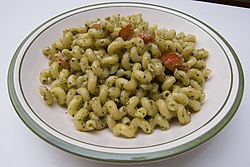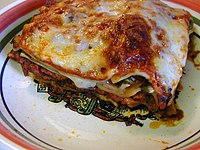Pasta
From Wikipedia, the free encyclopedia
Pasta (Italian for "dough") is a generic term for Italian variants of noodles, food made from a dough of flour, water and/or eggs, that is boiled. The word can also denote dishes in which pasta products are the primary ingredient, served with sauce or seasonings.
There are approximately 350 different shapes of pasta.[1] Examples include spaghetti (solid, thin cylinders), maccheroni (tubes or hollow cylinders), fusilli (swirls), and lasagne (sheets). Two other noodles, gnocchi and spätzle, are sometimes considered pasta. They are both traditional in parts of Italy. Pasta is categorized in two basic styles: Dried and Fresh. Dried pasta made without eggs can be stored for up to two years under ideal conditions, while fresh pasta will keep for a couple of days in the refrigerator.[2] In preparation for consumption, pasta is generally boiled.
|
From Italian pasta, from Latin pasta "dough, pastry cake, paste", from Greek πάστα (pasta) "barley porridge".
—[3]
|

Contents |
[edit] Ingredients
Pasta is made from a simple combination of flour and water. Pre-packaged speciality pasta often includes spices, cheese or added coloring from spinach, tomatoes or food dye.
Under Italian law, dry pasta (pasta secca) can only be made from durum wheat flour or durum wheat semolina[4]. Durum flour and durum semolina have a yellow tinge in color. Italian pasta is traditionally cooked al dente (Italian: "to the tooth", meaning not too soft). Abroad, dry pasta is frequently made from other types of flour (such as wheat flour), but this yields a softer product which cannot be cooked al dente.
Particular varieties of pasta may also use other grains and milling methods to make the flour, as specified by law[4]. Some pasta varieties, such as Pizzoccheri, are made from buckwheat flour. Fresh pasta may include eggs (pasta all'uovo). Some specialty pasta varieties can be made from grains low in gluten for gluten-intolerant people, or from whole wheat flour. Gnocchi are often listed among pasta dishes, although they are quite different in ingredients (mainly milled potatoes) and therefore can't be called pasta because they don't contain flour.
[edit] History

The works of the 2nd century AD Greek physician Galen mention itrion, homogeneous compounds made up of flour and water.[6] The Jerusalem Talmud records that itrium, a kind of boiled dough,[6] was common in the historic Land of Israel from the 3rd to 5th centuries AD.[7] But these references are vague and simply speculate on a possible connection to modern pasta.
A dictionary compiled by the 9th century Syrian physician and lexicographer Isho bar Ali defines itriyya as string-like shapes made of semolina and dried before cooking, probable evidence of Arab influence on the ancestor to modern-day dried pasta. One form of itrion with a long history is laganum (plural lagana), which in Latin refers to a thin sheet of dough.[8]
The Chinese were eating noodles made of millet as long ago as 2000 BC. This was confirmed by the discovery of a well-preserved bowl of millet noodles over 4000 years old[9]. However, durum wheat was not known in China until later times. The familiar legend of Marco Polo importing pasta from China[10] was born in the USA on the Macaroni Journal (published by an association of food industries with the goal of promoting the use of pasta in the USA) [11]. Marco Polo describes a food similar to "lagana" in his Travels, but he uses a term with which he was already familiar. Durum wheat, and thus pasta as it is known today, was introduced by Arabs during their conquest of Sicily according to the newsletter of the National Macaroni Manufacturers Association[12].
In the 1st century BC writings of Horace, lagana were fine sheets of dough which were fried[13] and were an everyday food.[8] Writing in the 2nd century Athenaeus of Naucratis provides a recipe for lagana which he attributes to the 1st century Chrysippus of Tyana: sheets of dough made of wheat flour and the juice of crushed lettuce, then flavored with spices and deep-fried in oil.[8] An early 5th century cookbook describes a dish called lagana that consisted of layers of dough with meat stuffing, a possible ancestor of modern-day Lasagna.[8] But the method of cooking these sheets of dough do not correspond to our modern definition of either a fresh or dry pasta product. The first concrete information concerning pasta products in Italy dates from the thirteenth or fourteenth century.[14] The question of Pasta's origin continues to evoke speculation. The name (λαγάνα, lagána) survives in modern-day Greece to denote an unleavened, flat bread eaten during the Great Lent.[citation needed] The term "lagana" is also used in the Southern region of Calabria, where it indicates a flat noodle.[citation needed]
[edit] Varieties of pasta
[edit] Accompaniments

Pasta is generally served with some type of sauce. Common pasta sauces in Northern Italy include pesto and ragù alla bolognese, which usually adds meat to the sauce. In Central Italy, there are simple sauces such as tomato sauce, amatriciana and carbonara. Southern Italian sauces include spicy tomato, garlic, and olive oil, with the pasta often paired with fresh vegetables or seafood. Varieties include puttanesca, pasta alla norma (tomatoes, eggplant and fresh or baked cheese), pasta con le sarde (fresh sardines, pine nuts, fennel and olive oil), spaghetti aglio, olio e peperoncino (literally with garlic, [olive] oil and hot chili peppers).
Fettuccine alfredo (although nonexistent in Italy), with cream and cheese, and spaghetti with tomato sauce (with or without ground meat or meatballs) are popular Italian-style dishes in the United States.
As pasta was introduced elsewhere in the world, it became incorporated into a number of local cuisines, which often have significantly different ways of preparation from those of Italy. In Hong Kong, the local Chinese have adopted pasta, primarily spaghetti and macaroni, as an ingredient in the Hong Kong-style Western cuisine. In Cha chaan teng, macaroni is cooked in water and served in broth with ham or frankfurter sausages, peas, black mushrooms, and optionally eggs, reminiscent of noodle soup dishes. This is often a course for breakfast or light lunch fare.[15] This method often involves cooking the pasta well beyond the al dente stage and washing the starches off the pasta after cooking, measures frowned upon in Italy or in Hong Kong's more authentic Italian eateries.
[edit] See also
[edit] References
- ^ "History of Pasta". http://www.lifeinitaly.com/food/pasta-history.asp. Retrieved on 2008-04-06.
- ^ "BBC Food - Get cooking - Pasta". http://www.bbc.co.uk/food/get_cooking/cooks_guide/pasta.shtml. Retrieved on 2008-04-06.
- ^ "pasta - Wiktionary". http://en.wiktionary.org/wiki/pasta. Retrieved on 2008-04-06.
- ^ a b | Presidential decree 9 February 2001, law #187
- ^ Watson, Andrew M (1983). Agricultural innovation in the early Islamic world. New York: Cambridge University Press. p. 22-3
- ^ a b Serventi & Sabban 2002:17
- ^ Serventi & Sabban 2002:29
- ^ a b c d Serventi & Sabban 2002:15–16
- ^ Lu, Houyuan, et al. (13 October 2005). "Culinary archaeology: Millet noodles in Late Neolithic China". Nature 437: 967–968. DOI:10.1038/437967a. news abstract.
- ^ National Pasta Association article FAQs section "Who "invented" pasta?"
- ^ S.Serventi F.Sabban La pasta. Storia e cultura di un cibo universale,VII. Economica Laterza 2004
- ^ Serventi, Silvano; Françoise Sabban (2002). Pasta: The Story of a Universal Food. Trans. Antony Shugaar. New York: Columbia University Press. pp. 10. ISBN 0231124422.
- ^ Serventi & Sabban 2002:24
- ^ Serventi, Silvano; Françoise Sabban (2002). Pasta: The Story of a Universal Food. Trans. Antony Shugaar. New York: Columbia University Press. pp. 10. ISBN 0231124422.
- ^ AP, Explore the world of Canto-Western cuisine, January 8, 2007 http://www.msnbc.msn.com/id/16440507/
[edit] External links
- Pasta shapes – history and an abridged list of pasta shapes.
| Wikimedia Commons has media related to: Pasta |
| Wikibooks Cookbook has a recipe/module on |
|
|||||||||||||||||












